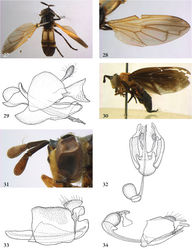Aristosyrphus
| Notice: | This page is derived from the original publication listed below, whose author(s) should always be credited. Further contributors may edit and improve the content of this page and, consequently, need to be credited as well (see page history). Any assessment of factual correctness requires a careful review of the original article as well as of subsequent contributions.
If you are uncertain whether your planned contribution is correct or not, we suggest that you use the associated discussion page instead of editing the page directly. This page should be cited as follows (rationale):
Citation formats to copy and paste
BibTeX: @article{Reemer2013ZooKeys288, RIS/ Endnote: TY - JOUR Wikipedia/ Citizendium: <ref name="Reemer2013ZooKeys288">{{Citation See also the citation download page at the journal. |
Ordo: Diptera
Familia: Syrphidae
Name
Aristosyrphus Curran – Wikispecies link – Pensoft Profile
- Aristosyrphus Curran, 1941: 247. Type species: Aristosyrphus primus Curran, 1941: 252, by original designation.
- Protoceratophya Hull, 1949: 314. Type species: Ceratophya carpenteri Hull, 1945: 76, by original designation. For synonymy see Cheng and Thompson (2008)[1].
- Paraceratophya Fluke, 1957: 38. Misspelling of Protoceratophya Hull.
- Eurypterosyrphus(Subgenus) Barretto & Lane, 1947: 141. Type species: Eurypterosyrphus melanopterus Barretto & Lane, 142, by original designation. Status as subgenus: Cheng and Thompson (2008)[1].
Description
Aristosyrphus (Aristosyrphus). Body length: 6–18 mm. Slender flies, often with constricted abdomen. Head wider than thorax. Face convex or almost straight in profile; about as wide as an eye or narrower. Lateral oral margins not produced. Vertex flat. Occiput narrow over entire length. Eye bare. Eyes in male weakly converging at level of frons, with mutual distance 2 to 3 times the width of antennal fossa. Antennal fossa about as wide as high. Antenna longer or shorter than distance between antennal fossa and anterior oral margin; basoflagellomere longer than scape, oval; bare. Postpronotum pilose. Scutellum semicircular; without calcars. Anepisternum without or with weak sulcus; anteriorly pilose or bare, posteriorly pilose, with pile limited to dorsal half. Anepimeron entirely pilose. Katepimeron convex; bare. Wing: vein R4+5 without posterior appendix; vein M1 making acute angle with vein R4+5, anterior part or entire vein M1 parallel to wing margin; postero-apical corner of cell r4+5 angular, with small appendix; crossvein r-m located within basal 1/7 of cell dm, often very close to base. Abdomen elongate: slightly oval, parallel-sided or constricted at segment 2; more than twice as long as wide. Tergites 3 and 4 fused. Male genitalia: phallus unfurcate, straight or bent dorsad; ejaculatory hood apicodorsally separately developed from actual phallus into prong-like structure, which may be mistaken for dorsal aedeagal process, but does not contain a sperm-duct; apical part of hypandrium consists of two separate lobes (separated ventromedially); epandrium without ventrolateral ridge; surstylus furcate or unfurcate.
Description
Aristosyrphus (Eurypterosyrphus) Body length: 8-14 mm. Slender flies with parallel-sided, constricted or kite-shaped abdomen. Head wider than thorax. Face more or less straight, with median tubercle on dorsal half; about as wide as an eye or narrower. Vertex flat. Occiput narrow over entire length. Eye bare. Eyes in male not or only slightly converging at level of frons, with mutual distance 4 to 5 times the width of antennal fossa. Antennal fossa about as wide as high. Antenna longer than distance between antennal fossa and anterior oral margin; basoflagellomere shorter or longer than scape, oval, sometimes appearing swollen: more than twice as wide as scape; bare. Postpronotum pilose. Scutellum semicircular; without calcars. Anepisternum without or with weak sulcus; pilose on dorsal half, bare ventrally. Anepimeron pilose on dorsal half, bare ventrally. Katepimeron convex; bare. Wing: vein R4+5 without posterior appendix; vein M1 making straight or acute angle with vein R4+5; postero-apical corner of cell r4+5 angular, with small appendix; crossvein r-m located around basal 1/3 of cell dm. Abdomen parallel-sided, constricted or kite-shaped; more than twice as long as wide. Tergites 3 and 4 fused. Male genitalia: phallus unfurcate, straight or bent dorsad; ejaculatory hood apicodorsally enveloping phallus; apical part of hypandrium consists of two separate lobes (separated ventromedially); hypandrium in some species with elongate ventromedian structure parallel to phallus Figs 32, 34), resembling the lingula of certain taxa of the subfamily Syrphinae; epandrium without ventrolateral ridge; surstylus furcate or unfurcate.
Diagnosis
Vein R4+5 without posterior appendix. Abdomen elongate and parallel-sided or constricted. Postpronotum pilose. Mesoscutum with transverse suture incomplete. Antenna longer than distance between antennal fossa and anterior oral margin.
Aristosyrphus s.s. Vein M1 oblique, at least anterior half parallel to wing margin. Face evenly convex. Anepimeron entirely pilose. Crossvein r-m located around basal 1/3 of cell dm. Ejaculatory hood apicodorsally developed into prong-like structure, separate from actual phallus (phallus may seem furcate under casual observation, but ejaculatory hood does not contain sperm duct).
Eurypterosyrphus. Vein M1 oblique or straight. Face with median tubercle. Anepimeron bare on ventral half. Crossvein r-m located within basal 1/7 of cell dm. Ejaculatory hood apicodorsally enveloping phallus, not developed into separate, prong-like structure.
Discussion
Morphological variation within this group is large, especially in the male genitalia (Figs 29, 32–34). In some specimens of Aristosyrphus primus Curran, 1941 an anterior stump is present at vein M (Fig. 28). This character has always been used as diagnostic for Mixogaster (Hull 1954[2], Cheng and Thompson 2008[1]).
Diversity and distribution
Described species: 7 (Aristosyrphus s.s.: 4; Eurypterosyrphus: 3). Several undescribed species are known to the first author. Central and South America.
Taxon Treatment
- Reemer, M; Ståhls, G; 2013: Generic revision and species classification of the Microdontinae (Diptera, Syrphidae) ZooKeys, 288: 1-213. doi
Other References
- ↑ 1.0 1.1 1.2 Cheng X, Thompson F (2008) A generic conspectus of the Microdontinae (Diptera: Syrphidae) with the description of two new genera from Africa and China. Zootaxa 1879: 21-48.
- ↑ Hull F (1954) The genus Mixogaster Macquart (Diptera, Syrphidae). American Museum Novitates 1652: 1-28.
Images
|
